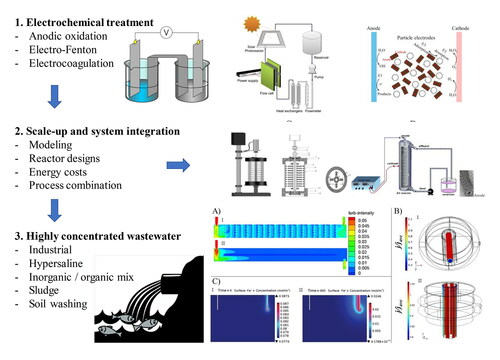Biological Wastewater Treatment
C. P. Leslie Grady Jr., Glen T. Daigger, Nancy G. Love, Carlos D. M. Filipe
Following in the footsteps of previous highly successful and useful editions, Biological Wastewater Treatment, Third Edition presents the theoretical principles and design procedures for biochemical operations used in wastewater treatment processes. It reflects important changes and advancements in the field, such as a revised treatment of the microbiology and kinetics of nutrient removal and an update of the simulation of biological phosphorous removal with a more contemporary model.
Practical Applications of Hydrogen Peroxide for Wastewater Treatment
Wilfried Eul, Gerd Scherer, Oswald Helmling
The increased environmental awareness requires reviewing production technologies and waste treatment processes differently. Previously disposed of waste has to be looked at again to verify whether its disposal meets current regulations.
The chemical destruction of waste products shows that it can solve past, present and future problems. Chemical treatments based on hydrogen peroxide (H2O2) or other active oxygen (AO) products (e.g. sodium percarbonate, sodium chlorate, etc.) are environmentally safe, effective and do not create hazardous byproducts.
Wastewater treatment systems based on H2O2 or AO products can be grouped into three (3) categories.
Natural Wastewater Treatment Systems
Ronald W. Crites, E. Joe Middlebrooks, Sherwood C. Reed
Although initially based purely on environmental principles of reuse and recycling, natural waste treatment systems proved to have economic advantages over mechanical systems in many cases, being less expensive to build and operate as well as requiring less energy. Thus, natural waste treatment methods reemerged even as advanced wastewater treatment technologies exploded in growth. Reflecting this burgeoning popularity, Natural Wastewater Treatment Systems is the first book to integrate all the major types of natural treatment systems into a single source.
Self-forming Dynamic Membranes for Wastewater Treatment
Published in Separation & Purification Reviews
Jessa Marie J. Millanar-Marfa, Laura Borea, Fabiano Castrogiovanni, Shadi Wajih Hasan, Kwang-Ho Choo, Gregory V. Korshin, Mark Daniel G. de Luna, Florencio C. Ballesteros, Vincenzo Belgiorno, Vincenzo Naddeo
Introduction Self-forming dynamic membrane (SFDM) technology has been gaining significant interest due to its potential advantages, notably lower capital and operational cost and easier fouling control, over conventional membranes used in membrane bioreactors. SFDM technology utilizes inexpensive support material integrated with a dynamic membrane (DM) made of suspended solids and biomass to provide high effluent quality. Objectives This paper aims to bridge the gap between the previous reviews and the current studies to provide a comprehensive review on SFDM applications to both aerobic and anaerobic bioreactors. Literature review The historical development of DMs since the 1960s up to the present is presented. Specific attention was given to DM formation mechanisms, deposition time, impacts of design, and operational factors (mesh characteristics and sludge properties) on DM formation and performances and on DM-based integrated systems. Abbreviations AnDMBR, anaerobic dynamic membrane bioreactor; CFV,crossflow velocity; COD,chemical oxygen demand; DM,dynamic membrane; DO,dissolved oxygen; EPS,extracellular polymeric substances; F/M,food to microorganisms ratio; HRT,hydraulic retention time; J,flux; MBR,membrane bioreactor; MF,microfiltration; MLSS,mixed liquor suspended solids; PSD,particle size distribution; RO,reverse osmosis; SEM,scanning electron microscopy; SFDM,self-forming dynamic membrane; SMP,soluble microbial products; SRT,sludge retention time; SS,suspended solids; TMP,transmembrane pressure; TN,total nitrogen; TP,total phosphorus; TSS,total suspended solids; UF,ultrafiltration
Methanotrophic denitrification in wastewater treatment: microbial aspects and engineering strategies
Published in Critical Reviews in Biotechnology
R. B. Costa, P. N. L Lens, E. Foresti
Anaerobic technologies are consolidated for sewage treatment and are the core processes for mining marketable products from waste streams. However, anaerobic effluents are supersaturated with methane, which represents a liability regarding greenhouse gas emissions. Meanwhile, anaerobic technologies are not capable of nitrogen removal, which is required to ensure environmental protection. Methane oxidation and denitrification processes can be combined to address both issues concurrently. Aerobic methane oxidizers can release intermediate organic compounds that can be used by conventional denitrifiers as electron donors. Alternatively, anoxic methanotrophic species combine methane oxidation with either nitrate or nitrite reduction in the same metabolism. Engineered systems need to overcome the long doubling times and low NOx consumption rates of anoxic methanotrophic microorganisms.
Hydrothermal treatment of pharmaceutical wastewater
Published in Indian Chemical Engineer
The effective disposal of industrial pharmaceutical waste waters with the desired quality has become a challenge. Supercritical water oxidation which involves water beyond critical point has been preferred due to its near complete conversions. This research work made an attempt to degrade the organic matter into fuel gases by gasifying the pharmaceutical waste water stream over sub- to supercritical temperature range (200–400°C). A maximum of 126.5 mmol/L of H2 gas yield was obtained at 400°C for 45 min. To achieve complete conversion, supercritical experiments have been performed in the presence of H2O2. The experiments resulted near complete conversion of 99.5% for an oxidation coefficient of 4 at 400°C in 5 min. The experimental results conveyed that useful products (H2, CO and CH4) can be attained with gasification in the absence of oxidant, while complete conversion can be achieved in the presence of oxidant in supercritical water.
Microalgae as promising source for integrated wastewater treatment and biodiesel production
Published in International Journal of Phytoremediation
Soufiane Fal, Redouane Benhima, Najib El Mernissi, Yassin Kasmi, Abdelaziz Smouni, Hicham El Arroussi
Microalgae have been studied for their potential of wastewater treatment as well as a promising source for biodiesel production. This study investigates the potential of microalgae to remove nutrients from domestic wastewater (DWW) while producing lipids-rich biomass for biodiesel production. Eight microalgae were cultivated in (DWW) to evaluate their nutrients removal capacity and biomass production. Total phosphorus (TP) of DWW reduced from 2 mg L−1 to 0.02 mg L−1 with the treatment efficiency of 99.15% and the highest performance was noted in Chlamydomonas reinhardtii (C. reinhardtii). For total nitrogen (TN), treatment efficiency climbed to 99.07%. It is reduced from 18.35 to 0.17 mg L−1 recorded in C. reinhardtii and Chlorella pyrenoidosa (C. pyrenoidosa). On the other hand, all microalgae showed a high lipids-rich biomass in wastewater compared to BG11.
 China
China  Africa
Africa 

